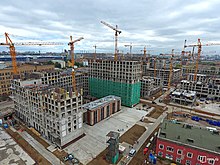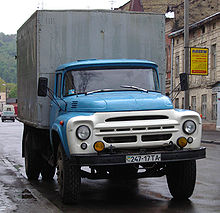Zavod imeni Likhacheva
Coordinates: 55 ° 41 ′ 41 ″ N , 37 ° 38 ′ 26 ″ E
| Завод имени Лихачёва (ЗИЛ) Sawod imeni Lichatschowa (ZIL or SIL)
|
|
|---|---|
| legal form | Corporation |
| founding | 1916 |
| resolution | 2013 |
| Reason for dissolution | insolvency |
| Seat | Moscow |
| management | Igor Sakharov |
| Number of employees | 23,000, (as of 1999) |
| sales | 3.6 billion rubles |
| Branch | vehicle construction |
| Website | www.amo-zil.ru |
Sawod imeni Lichatschowa ( Russian Завод имени Лихачёва ; scientific transliteration Zavod imeni Lichačëva , German Lichatschow-Werk, abbreviation: ZIL or also SIL , Russian ЗИЛ ) was the oldest Russian manufacturer of trucks, buses and limousines. The company was based in Moscow until its dissolution in 2013 and was most recently 90% owned by the Russian state.
Founded in 1916 as AMO , the plant was called from 1931 until the de-Stalinization from 1956 Sawod imeni Stalina ( Russian Завод имени Сталина , scientific transliteration Zavod imeni Stalina , German Stalinwerk, abbreviated ZIS or SIS , Russian ЗИС) .
history
The company was created as part of a government program to build an automotive industry in Russia , which included the construction of six new automobile factories. The architect and entrepreneur Alexander Wassiljewitsch Kuznetsov and the entrepreneur brothers Sergei , Vladimir and Stepan Pawlowitsch Ryabuschinski joined forces to build such a factory and opened the company Kuznetsov, Ryabushinsky , which the businessman Nikolai Alexandrovich Wtorov joined. In February 1916, the military technology headquarters commissioned Kuznetsov, Ryabushinsky & Co. to build an automobile factory and deliver 1,500 automobiles for a total of 27 million rubles . The factory should be completed no later than October 1916, and at least 150 automobiles should have been delivered by March 1917. The company was named AMO (Russian: Автомобильное московское общество, transliterated: Avtomobilnoje Moskowskoje Obschtschestwo, German: Moskauer Automobilgesellschaft). The Ryabushinsky brothers signed a license agreement with Fiat to build the Fiat 15 light military truck . The plant was built on the Tyufelewa Roschtscha in the south of Moscow under the direction of Alexander Wassiljewitsch Kuznetsov and Artur Ferdinandowitsch Loleit . Konstantin Stepanowitsch Melnikow designed the building facades . The first director was Dmitri Dmitrievich Bondarev . Because of the First World War , however, there was no independent production, and the company limited itself to the assembly of components purchased from Fiat. Series production only came about after the revolution and civil war .
The first renaming of the plant took place on April 30, 1923. The name AMO was deleted and replaced by Awtomobilny Moskowski Sawod imeni Ferrero (Russian Автомобильный московский завод им. Ферреро, after Pietro Ferrero ). The next renaming took place as early as 1925. The new name was First State Automobile Plant (Russian 1-й Государственный автомобильный завод; transcribed 1-i Gossudarstwenny Awtomobilny Sawod ), which is abbreviated as 1-i GAZ (Russian 1-й ГАЗ).
The first series-produced truck was built in 1924. It was a replica of the FIAT F-15 and was named AMO-F-15 . The company thus became the first vehicle manufacturer in the Soviet Union . The trademark of the AMO trucks was a round emblem that showed the three letters in a yellow circle on a red background . It was modified somewhat in the course of the company's history.
From 1931 the combine was called Zavod imeni Stalina (ZIS) (Russian abbreviated ЗИС, German Stalin-Werk), named after Josef Stalin . With the de-Stalinization after the XX. CPSU party congress of 1956 named Zavod imeni Lichatschowa , or ZIL for short. Ivan Alexejewitsch Lichatschow was director of the AMO or ZIS plant and was so politically unencumbered that the plant was named after him.
After the collapse of the Soviet Union , the now Russian company was privatized in 1992. Since then, the official name has been the Moscow Open Stock Corporation "Zavod imeni IA Lichatschowa" (AMO-ZIL) .
With the collapse of the Soviet Union, ZIL presented itself with considerable problems. Sales of outdated vehicles collapsed and new models could hardly be established. The factory, which was designed to produce 200,000 trucks per year, still produced 16,458 vehicles in 2001, 6,954 in 2005 and 985 in 2012. It is unclear exactly when official series production ended. In 2013, 95 vehicles were still built, the last truck left the factory or its remains in 2016. It was sold to a company that uses the vehicle in regular traffic. As early as 2010, the company had shifted to selling equipment, materials, machines and spare parts in order to be able to continue paying employees' wages despite large debts.
The huge factory area in Moscow was largely cleared from 2012/13 to 2015 and the factory halls demolished. There are plans to build residential and commercial buildings at the former location.
production
At ZIL mainly trucks were manufactured, in addition there was the production of large representative limousines as a separate division. In the Soviet era they were built exclusively for the top elite of the state. The trucks were also manufactured under license in Bulgaria and China during the Soviet era. The Hungarian bus manufacturer Ikarus used chassis from ZIL.
Paccar worked with ZIL on the production of the Kenworth trucks and Volvo negotiated to work together on the development of the FH12 trucks. The truck division of ZIL works with the American manufacturer Caterpillar and temporarily installed its engines in its vehicles.
The sedans were basically based on American models from the 1950s and had corresponding V8 engines (7700 cm³ displacement). Despite the constantly modernized body shape, the vehicles were recently outdated.

The ZIL-117 and ZIL-4104 models can be seen quite often in photos of the Soviet government . The bodies differed only slightly. The ZIL-117 had round twin headlights and a flat grille . Later, typical square headlights and a slightly raised radiator grille were installed for American vehicles of the late 1970s and 1980s. There was a short and a long version of both models. The ZIL-3103 was a convertible for special representation rides at parades.
In the subsidiary Brjanski Awtomobilny Sawod , vehicle parts such as axles, and later military vehicles, for example the ZIL-135 model, were produced from the late 1950s . The plant currently produces heavy truck chassis as well as crane undercarriages.
In its history, ZIL produced around 8 million motor vehicles, 5.5 million refrigerators (1951–2000) and 3.24 million bicycles (1951–1959). The motor vehicles included 7,853,985 trucks (1924–2006), 39,501 buses (1927–1961, since 1993) and 12,145 sedans (1936–2006). The truck production was 1975-1989 with an output of 195,000 to 210,000 pieces per year. 630,000 vehicles were exported to a total of 51 countries worldwide.
Models
Automobiles
- ZIS-101 (1936/37)
- ZIS-102 (1938)
- ZIS-110 (1946)
- ZIS-115 (1946, according to other sources also as early as September 1944)
- ZIL-111 (1958)
- ZIL-114 (1967), further development ZIL-117 (1971)
- ZIL-4104 (1978), later ZIL-41041 and ZIL-41047
- ZIL-4105
- ZIL-4112 (presented in 2012, start of production planned for 2013)
truck
- AMO-F-15 (1924)
- AMO-2 (1930, copy of US Autocar Dispatch SA )
- AMO-3 (1931)
- ZIS-5 (1933)
- ZIS-6 (1934)
- ZIS-22 (1938)
- ZIS-42 (1942)
- ZIS-128 (1954)
- ZIS-150 (1947)
- ZIS-151 (1948)
- ZIL-164 (1957)
- ZIL-157 (1958)
- ZIL-130 (1962)
- ZIL-131 (1967)
- ZIL-133 (1966)
- ZIL-135 (1966)
- ZIL-5301 "Bychok" ("Bully") (1992)
- ZIL-6404 (1996)
- ZIL-6309 (1999)
- ZIL-6409 (1999)
- ZIL-433180 (2003)
- ZIL-432930 (2003)
- ZIL-4327 (2004?)
- ZIL-4334 (2004)
buses
- AMO-4 (1931)
- ZIS-8 (1934)
- ZIS-lux (1934) (prototype)
- ZIS-16 (1938)
- ZIS-17 (1939) (prototype)
- ZIS-154 (1946)
- ZIS-155 (1949)
- ZIS-127 (1956)
- ZIL-158 (1957)
- ZIL-159
- ZIL-118 "Junost" (1962)
- ZIL-3250 (1998)
Sports and racing cars
Army vehicles and other production
- ZIS-2
- ZIS-3 (field cannon)
- Combat gun ZIS-5, a model variant of the F-34
- ZIS-152 (armored personnel carrier)
- ZIL-153 (armored personnel carrier)
- ZIS-485 (amphibious vehicle)
- ZIL-E167 all -terrain vehicle (prototype only, 1962)
- ZIL-4906 (amphibious vehicle)
- ZIL-29061 ( all -terrain vehicle with worm drive)
literature
- LM Shugurov: АВТОМОБИЛИ. России и СССР. First part. Ilbi / Prostreks, Moscow 1993, ISBN 5-87483-004-9 .
- Halwart Schrader , Jan P. Norbye: The truck lexicon, all brands 1900 to today . Motorbuch Verlag; 3. Edition. 1998, ISBN 3-613-01837-3 .
- AM Gljomin, FP Melnikow, AM Tretyakov: История отечественного автомобилестроения . Technical University of Biysk ,, 2013.
Individual evidence
- ^ Report from the newspaper "The Moscow Times" on innovations in urban transport , February 4, 1999.
- ↑ 99 Years of ZiL: From Car Plant to Potential New Hear of Moscow? In: The Moscow Times . November 12, 2015 ( themoscowtimes.com [accessed May 6, 2018]).
- ↑ Соколов М .: АМО-Ф15, знакомый и незнакомый . In: Автомобильный моделизм . No. 6 , 2004, p. 17-20 .
- ↑ Реминский В. А .: Первый блин советского автопрома АМО Ф-15 . In: Наука и техника . No. 1 , 2006.
- ↑ SIL: Этапы становления: 1916–1923 (accessed on May 6, 2018).
- ↑ Website on the factory history (Russian)
- ↑ Announcement about the last truck manufactured by ZIL in 2016 (Russian)
- ↑ a b c Journal article on the history and decline of ZIL (Russian)
- ↑ Photo documentation on the status of the demolition from July 2015 (Russian)
- ^ Official website of the Bryansky Avtomobilny Zavod (Russian)
- ↑ History of the BAZ plant (Russian)
- ↑ AM Gljomin, FP Melnikow, AM Tretyakov: История отечественного автомобилестроения . P. 28.
Web links
- Information on ZIL vehicles ( Memento from December 25, 2001 in the Internet Archive )
- Information and pictures
- Official website of the manufacturer ZIL
- History of ZIL production in Russian
- Photo series: ZIL factory halls: From a Soviet production giant to a ghost factory










